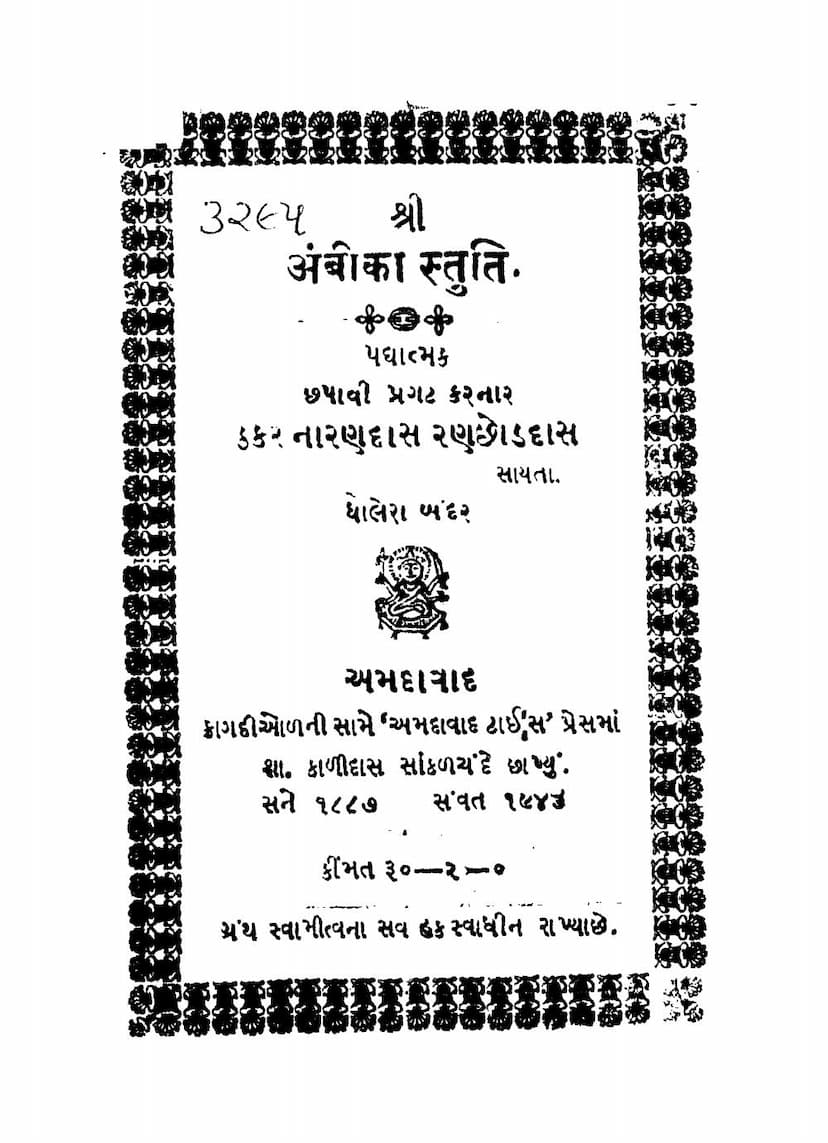Ambika Stuti
Added to library: September 1, 2025

Summary
Here's a comprehensive summary of the Jain text "Ambika Stuti" by Narandas Ranchoddas, based on the provided catalog link and the Gujarati text:
Ambika Stuti: A Hymn of Devotion to Goddess Ambika
"Ambika Stuti" is a collection of devotional hymns written in a poetic format, dedicated to the Jain goddess Ambika. The book was published by Narandas Ranchoddas and printed in 1887 (Savant 1943) at the Ahmedabad Print Works. The author, Narandas Ranchoddas, dedicates the work with deep humility and gratitude to Mr. Thakkar Pitamberdas V. Chhaganlal Vadhani, acknowledging his immense support and encouragement in the creation of this book, as well as his broader contributions to societal progress and patriotism. The book also expresses gratitude to Maharaja Dhiraj Shri Jaswantsinghji Saheb Bahadur for his support.
The hymns are primarily composed in Gujarati and are intended to be sung in various traditional Indian ragas (melodies). The core theme of the text is the glorification of Goddess Ambika, who is depicted as a benevolent and powerful deity who bestows blessings, removes obstacles, and grants liberation.
Key Themes and Content:
- Invocation of Ganesha: The stuti begins with an invocation to Lord Ganesha, the remover of obstacles and the deity worshipped at the beginning of any auspicious undertaking. The verses express devotion to Ganesha and seek his grace for the successful completion of the book.
- Praise of Ambika's Divine Form: A significant portion of the text is dedicated to vividly describing the divine form and attributes of Goddess Ambika. The descriptions are rich with imagery, painting a picture of her as:
- Radiant and Beautiful: Her face is compared to the sun, her ears adorned with luminous kundalas (earrings) resembling the sun and moon.
- Majestically Adorned: She is depicted wearing a golden crown, pearl necklaces, diamond-studded armbands, anklets with bells, and a beautiful sari.
- Powerful and Graceful: She sits on a lion (simhasana), exuding grace and power. Her presence brings joy and auspiciousness.
- Benevolent and Protective: She is described as the protector of the universe, the granter of boons, and the dispeller of suffering and enemies.
- Ambika's Role in Jainism: The hymns highlight Ambika's significance within Jain tradition as a powerful Yakshi (attendant goddess) often associated with the Tirthankaras, particularly Neminath. She is seen as a source of strength, prosperity, and spiritual attainment.
- Devotional Practices: The text implicitly encourages devotional practices such as singing her praises, visiting her temples, and meditating on her form.
- Expressions of Devotion and Surrender: The author repeatedly expresses his deep devotion, surrender, and reliance on Ambika. He seeks her grace for protection, well-being, and the fulfillment of his desires.
- Narrative Elements: Some verses recount stories or allusions to Ambika's divine actions, such as saving devotees from difficult situations or her role in protecting sages.
- Specific References: The text mentions "Arasur" (likely meaning Arasur, a significant pilgrimage site for Jains associated with Ambika) as her abode, emphasizing her connection to this sacred place.
- Call to Devotion: The stuti concludes with an exhortation for all people to worship and remember Ambika, promising liberation and happiness.
Overall Significance:
"Ambika Stuti" is a valuable devotional work that showcases the importance of Goddess Ambika in Jainism. Through its poetic verses and heartfelt expressions of faith, the book aims to inspire devotion, provide spiritual solace, and guide devotees towards the auspicious blessings of the Goddess. The inclusion of the publisher's notes, dedication, and list of patrons further contextualizes the book's creation and its reception within the Jain community at the time of its publication.